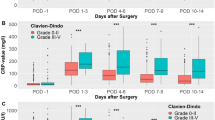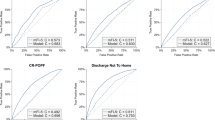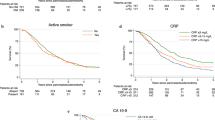Abstract
Introduction
The majority of pancreatic resections for malignancy are performed in older patients with major comorbidities. The aim of this study was to develop a preoperative nomogram based on the presence of comorbidities to predict risk of perioperative mortality.
Materials and Methods
The National Inpatient Sample database was queried to identify patients that underwent pancreatectomy for malignancy. The preoperative comorbidities identified as predictors were used, and a nomogram was created. Sample A (2000–2004) was utilized to develop the model, and sample B (2005) was utilized to validate this model.
Results
The overall actual observed perioperative mortality rate for samples A and B was 6.3% and 5.2%, respectively. The mean total points calculated for sample A by the nomogram was 131.7 that translates to a nomogram-predicted mortality rate of 4.9%, which is similar to the actual mortality. The mean total points for sample B was 128.1, which translates to a nomogram-predicted mortality rate of 4.6%. The similarity of mortality rates as predicted by the nomogram and a concordance index of 0.76 shows good agreement between the data and the nomogram.
Conclusion
This preoperative nomogram has been shown to accurately predict the risk of perioperative mortality following pancreatectomy for malignancy.




Similar content being viewed by others
References
http://www.cancer.org/downloads/STT/Cancer_Statistics_2008.ppt—accessed March 2009.
http://www.cancer.org/downloads/STT/2008CAFFfinalsecured.pdf—accessed March 2009.
Winter JM, Cameron JL, Campbell KA, Arnold MA, Chang DC, Coleman J, Hodgin MB, Sauter PK, Hruban RH, Riall TS, Schulick RD, Choti MA, Lillemoe KD, Yeo CJ. 1423 pancreaticoduodenectomies for pancreatic cancer: a single-institution experience. J Gastrointest Surg 2006;10:1199–1210.
Cameron JL, Riall TS, Coleman J, Belcher KA. One thousand consecutive pancreaticoduodenectomies. Ann Surg 2006;244:10–15.
Vin Y, Sima CS, Getrajdman GI, Brown KT, Covey A, Brennan MF, Allen PJ. Management and outcomes of postpancreatectomy fistula, leak and abscess: results of 908 patients resected at a single institution between 2000 and 2005. J Am Coll Surg 2008;207:490–498.
McPhee JT, Hill JS, Whalen GF, Zayaruzny M, Litwin DE, Sullivan ME, Anderson FA, Tseng JF. Perioperative mortality for pancreatectomy. A national perspective. Ann Surg 2007;246:246–253.
Elixhauser A, Steiner C, Harris DR, Coffey RM. Comorbidity measures for use with administrative data. Med Care 1998;36:8–27.
Research Triangle Institute. SUDAAN Language Manual, Release 10.0 Research Triangle Park. 2008.
Iasonos A, Schrag D, Raj GV, Panageas KS. How to build and interpret a nomogram for cancer prognosis. J Clin Oncol 2008;26:1364–1370.
Brittain E. Probability of coronary heart disease developing. West J Med 1982;136:86–89.
Asiyanbola B, Chang D, Gleisner AL, Nathan H, Choti MA, Schulick RD, Pawlik TM. Operative mortality after hepatic resection: are literature-based rates broadly applicable? J Gastrointest Surg 2008;12:842–851.
Sohn TA, Yeo CJ, Cameron JL, Lillemoe KD, Talamini MA, Hruban RH, Sauter PK, Coleman J, Ord SE, Grochow LB, Abrams RA, Pitt HA. Should pancreaticoduodenectomy be performed in octogenarians? J Gastrointest Surg 1998;2:207–216.
Makary MA, Winter JM, Cameron JL, Campbell KA, Chang D, Cunningham SC, Riall TS, Yeo CJ. Pancreaticoduodenectomy in the very elderly. J Gastrointest Surg 2006;10:347–356.
Riall TS, Reddy DM, Nealon WH, Goodwin JS. The effect of age on short-term outcomes after pancreatic resection: a population-based study. Ann Surg 2008;248:459–467.
Lieberman MD, Kilburn H, Lindsey M, Brennan MF. Relation of perioperative deaths to hospital volume among patients undergoing pancreatic resection for malignancy. Ann Surg 1995;222:638–645.
Fong Y, Gonen M, Rubin D, Radzyner M, Brennan MF. Long term survival is superior after resection for cancers in high-volume centers. Ann Surg 2005;242:540–544.
Meguid RA, Ahuja N, Chang DC. What constitutes a “high-volume” hospital for pancreatic resection? J Am Coll Surg 2008;206:622.
Riall TS, Nealon WH, Goodwin JS, Townsend CM Jr, Freeman JL. Outcomes following pancreatic resection: variability among high-volume providers. Surgery 2008;144:133–140.
Eastham JA, Kattan MW, Scardino PT. Nomograms as predictive models. Semin Urol Oncol 2002;20:108–115.
Kattan MW. Comparison of Cox regression with other methods for determining prediction models and nomograms. J Urol 2003;170:S6–S9.
Kattan MW, Leung DH, Brennan MF. Postoperative nomogram for 12-year sarcoma-specific death. J Clin Oncol 2002;20:791–796.
Kattan MW, Karpeh MS, Mazumdar M, Brennan MF. Postoperative nomogram for disease-specific survival after an R0 resection for gastric carcinoma. J Clin Oncol 2003;21:3647–3650.
Brennan MF, Kattan MW, Klimstra D, Conlon K. Prognostic nomogram for patients undergoing resection for adenocarcinoma of the pancreas. Ann Surg 2004;240:293–298.
Lin KY, Johns FR, Gibson J, Long M, Drake DB, Moore MM. An outcome study of breast reconstruction: presurgical identification of risk factors for complications. Ann Surg Oncol 2001;8:586–591.
Lagarde SM, Reitsma JB, Maris AD, van Berge Henegouwen MI, Busch OR, Obertop H, Zwinderman AH, van Lanschot JJ. Preoperative prediction of the occurrence and severity of complications after esophagectomy for cancer with use of a nomogram. Ann Thorac Surg 2008;85:1938–1946.
Harrell FE Jr, Lee KL, Mark DB. Multivariable prognostic models: issues in developing models, evaluating assumptions and adequacy, and measuring and reducing errors. Stat Med 1996;15:361–387.
Wong SL, Kattan MW, McMaster KM, Coit DG. A nomogram that predicts the presence of sentinel node metastasis in melanoma with better discrimination than the American Joint Committee on Cancer staging system. Ann Surg Onc 2005;12:282–288.
Acknowledgments
The authors would like to extend their sincere thanks to Dr. Murray F Brennan for his kind review of the manuscript and valuable suggestions.
Author information
Authors and Affiliations
Corresponding author
Additional information
Discussant
Dr. Keith D. Lillemoe (Indianapolis): I’d like to congratulate you for a great presentation. Your style of presentation and knowledge of the data were great. It was an outstanding job by a medical student.
The authors have constructed a nomogram based upon preoperative risk factors to predict perioperative mortality following pancreatic resection. The product of their efforts has been validated using a second patient sample from the same database. This work seems like a natural extension from prior publications from Memorial Sloan Kettering, the institution where the senior author, Dr. Are did his fellowship. Dr. Brennan and others at Memorial have constructed nomograms to predict the long term survival for many common tumors. The logic behind those nomograms is that they can be used to guide adjuvant therapy for patients at the greatest risk for recurrent disease.
I understand the reasons that you have provided us for this nomogram and how it might be useful, but, again, to bring up the point that was brought up on Saturday at the Pancreas Club, Karl Bilimoria from Northwestern has already demonstrated that we have a problem with people with resectable cancers of the pancreas being denied surgery, or even surgical consultation, because the opinions of either their primary care physicians or other physicians, that they are not surgical candidates.
This nomogram could provide ammunition for nonsurgeons to calculate their own predictions of mortality and potentially deny resectable patients the potential for surgery.
Is this really what we want, to take these decisions out of the hands of the surgeons and leave them in the hands of a non-surgeon who can evaluate a nomogram based on a series of risk factors that they can measure but without surgical judgment.
I know databases have limitations, but you’re missing a lot of important factors that might contribute to perioperative risk such as serum albumin, ASA class, weight loss, and coronary artery disease. You use size of hospital and teaching hospitals as a surrogate, but these factors do not necessarily reflect hospital volume or surgeon experience in pancreatic surgery. You also could have included Leap Frog criteria.
Finally, imitation is the highest form of flattery. At Saturday’s Pancreas Club meeting, Jennifer Tseng and her group presented an almost identical nomogram addressing the same points that you did, only with a different database.
Despite the fact that these are both very nice papers, I predict that I will never use them. Rather, I am going to sit down with the patient, going to look at all their comorbidities, at my own experience, and I am going to look at the tumor, and I am going to put all these points together, make the decision whether to offer the patient an operation. I am not going to make this decision based on a calculated nomogram, but surgical judgment and experience.
I have one final question. After using the nomogram to determine that the lady you described with an 18% mortality, Dr. Are, did you offer her an operation? And if you did, then I can’t believe you really are going to ever apply this nomogram.
Discussant
Dr. Sean Mulvihill (University of Utah, Salt Lake City, Utah): I think Dr. Lillemoe was a little hard on you. I think it actually would be useful to have a nomogram that you could use to sit down with a patient and predict mortality.
The problem with your study is that it’s not applicable to any individual hospital. So, for instance, in my own hospital, of the last 173 Whipple resections we have done there was one perioperative death, for a mortality rate of 0.7%. But in your inpatient sample, the mortality rate is far higher. So we couldn’t use your nomogram except to attribute an average mortality across the country. I think most of us would believe that the average results in the country are unacceptably poor right now.
The other weakness is that the inpatient sample is notoriously inaccurate at describing patient comorbidities. And if one looks, in contrast to your nomogram, at the model that we have previously published from the NSQIP program where the variables are more closely controlled, it’s quite different. And so I think your study is useful, but probably not the answer to this problem of prediction of outcome.
Closing discussant
Chantal Afuh: That is a good point. As Dr. Are mentioned, this is not a tool to replace experience. It is something that may be used to help discuss these risks with patients.
One may say to the patient, based on your health status, the comorbidities you have, you may have an increased risk, whether it be slightly increased risk to another patient who does not have these additional health concerns.
There definitely are some institutions that have better outcomes than the national average. It is possible that this is something you may not wish to use at your institution to replace what you all have done, but it may be useful to supplement the conversation you have with the patient so that they can better understand and provide informed consent.
Dr. Carlos Fernandez Del Castillo (Boston, MA): A quick comment as I rise and share Dr. Lillemoe’s concern that this study, as well as the one from the University of Massachusetts, could generate nihilism in terms of the applicability of pancreatic resection for patients with pancreatic cancer, and can be used as an argument against surgery.
Currently only 30% of pancreatic resections are done for pancreatic cancer. Many others are done for benign disease, like cystic tumors, where the risk profile could be very different, including a higher risk of fistula, which in turn can be a cause of death. So, I’m not really sure this is really generalizable.
Closing discussant
Chantal Afuh: That is a very good comment as well. The purpose of our nomogram, however, is to be used when patients do have a primary adenocarcinoma.
So this isn’t necessarily something that can be applicable at large to different disease conditions of the pancreas or periampullary conditions. It’s something to be used in this particular situation, which is perioperative mortality following pancreatectomy for pancreatic malignancy.
Rights and permissions
About this article
Cite this article
Are, C., Afuh, C., Ravipati, L. et al. Preoperative Nomogram to Predict Risk of Perioperative Mortality Following Pancreatic Resections for Malignancy. J Gastrointest Surg 13, 2152–2162 (2009). https://doi.org/10.1007/s11605-009-1051-z
Received:
Accepted:
Published:
Issue Date:
DOI: https://doi.org/10.1007/s11605-009-1051-z




